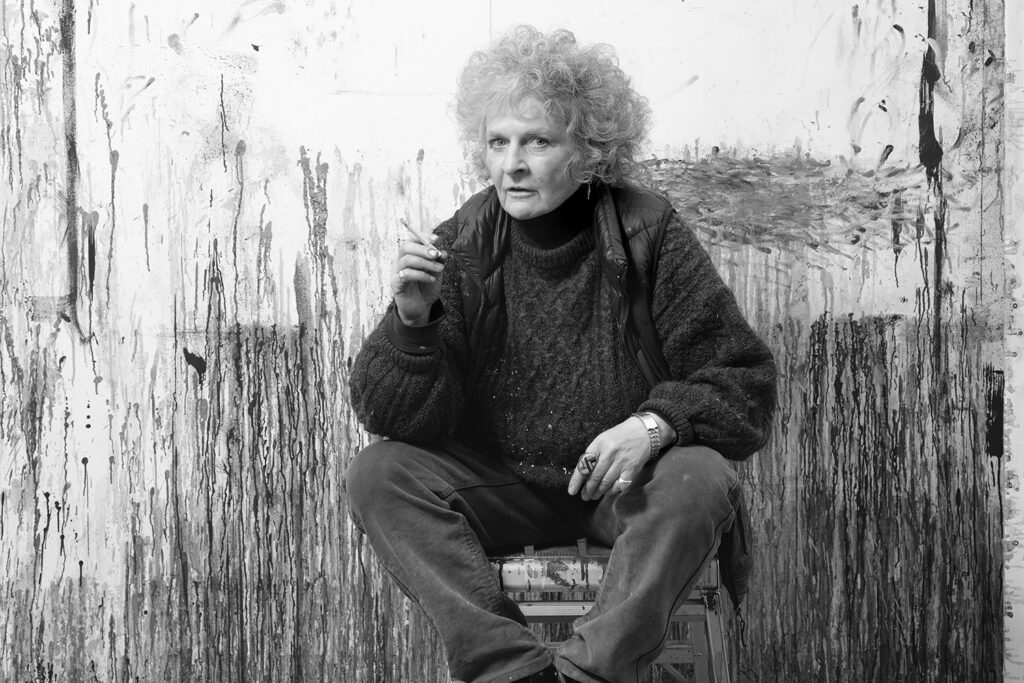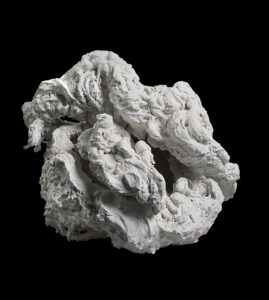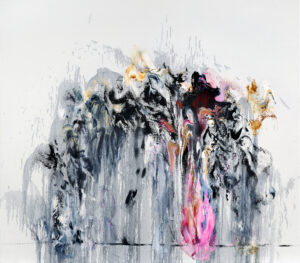Maggi Hambling speaks of her lifelong love affair with the North Sea
“My love affair with the North Sea began when I was a toddler…as my 80th year arrives, I listen”

Maggi Hambling. Image: Douglas Atfield
Maggi Hambling’s lifelong dialogue with the sea features in A World of Water, as part of the Sainsbury Centre’s Can the Seas Survive Us? season. The show featured three seminal works: You Are the Sea (2012), an immersive chorus of sound; the brooding, densely layered Wall of Water VIII (2011); and Wall of Water: Erosion (2023), awash with turbulent hues of blue and black. Each work is anchored in the shifting shorelines of the Suffolk coast.
John Kenneth Paranada, Curator of Art and Climate Change at the Sainsbury Centre, chats to Hambling about painting as a response to ecological collapse, the spiritual and material realities of a disappearing coastline, and the sea as a site of confrontation — where memory, myth, and planetary crisis converge.
In the age of rising oceans and relentless extraction, can the seas – and all those who live by, with, and through them – survive us?
JKP: Your work in A World of Water continues your long relationship with the sea — especially the Suffolk coast, which has been a constant subject in your painterly practice. What is it about this stretch of coastline that keeps drawing you back?
MH: My love affair with the North Sea began when I was a toddler: toddling into the sea and talking to it, ten to the dozen. As my 80th year arrives, I listen.
I became obsessed with the sluice at Thorpeness, a circular concrete structure above a well, where seawater is separated from freshwater. Sounds like trapped animals arise from its depths. In conceiving my installation, You are the sea, Tom Taylor and I suspended microphones to record these mysterious sounds. We mixed in lines from my poem You are the sea, and submerged these with other human cries. Visitors to the installation are encouraged to sit on the replica sluice, to look and to listen.

Maggi Hambling. Image: Douglas Atfield
JKP: Your seascapes — particularly the North Sea series — evoke the weather of emotions, portraying the sea as both a physical force and a powerful symbol. How does water help you explore feelings, presence, and transformation? And in painting along the ever-changing East Anglian coast, where erosion and retreat are constant, how has this sense of fragility influenced your relationship with the sea and the way you depict it?
MH: My sculpture Henrietta Eating a Meringue (2001), where the meringue becomes Henrietta’s mouth and vice versa, was — I now realise — the seminal work, pre-dating my North Sea waves. The mouth devouring the meringue; the waves devouring the shingle. That physicality, that merging of force and fragility, runs through all my sea paintings. The coastline’s constant change — its erosion, its refusal to stay still — echoes the emotional weather I seek to capture.

Maggi Hambling, ‘Henrietta eating a meringue’, 2001, plaster. Copyright: Maggi Hambling
JKP: The theme of this season — Can the Seas Survive Us? — turns the familiar question on its head. Rather than asking whether we can survive climate change, it asks whether the seas can survive us: our carbon emissions, our dependence on fossil fuels, and the systems that sustain environmental destruction and ecological collapse — from extractive industries to a culture of waste and unchecked consumption. Do you see your paintings as a warning, a lament, or something else altogether?

Maggi Hambling, Wall of Water VIII, 2011, oil on canvas. Copyright:
Maggi Hambling

Maggi Hambling, ‘Wall of Water: Erosion’, 2023, oil on canvas. Copyright: Maggi Hambling
MH: In response to the curatorial provocation at the Sainsbury Centre, the Wall of Water paintings (2010–ongoing) began when I witnessed a huge storm, where towering, thundering waves crashed down onto the polite sea wall at Southwold: the natural world confronting us. My Edge series of paintings (2014–ongoing) took over — laments upon our destruction of nature. Then the animals appeared: our criminal abuse of, and total disregard for, their kingdom.
JKP: Thank you for sharing your thoughts, Maggi. Your work powerfully shows how art can drive and activate ecological awareness. By engaging our senses and emotions, it highlights the deep connection between humanity and nature, reminding us that safeguarding marine ecosystems is crucial for the future of life on Earth.
You can see these three works by Maggi Hambling as part of A World of Water at the Sainsbury Centre, until 3 August, 2025.